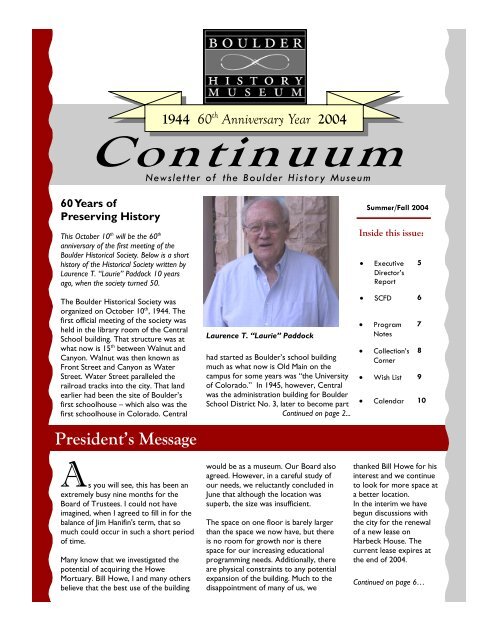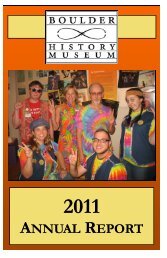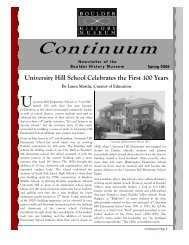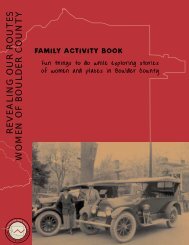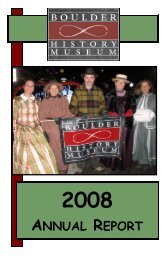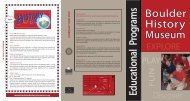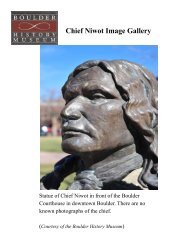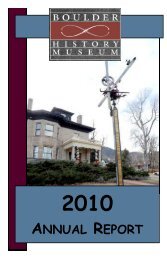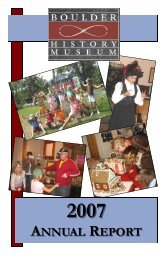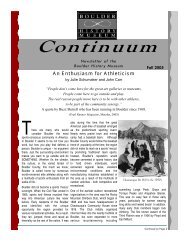Summer/Fall 2004 - Boulder History Museum
Summer/Fall 2004 - Boulder History Museum
Summer/Fall 2004 - Boulder History Museum
You also want an ePaper? Increase the reach of your titles
YUMPU automatically turns print PDFs into web optimized ePapers that Google loves.
1944 60 th Anniversary Year <strong>2004</strong><br />
Continuum<br />
Newsletter of the <strong>Boulder</strong> <strong>History</strong> <strong>Museum</strong><br />
60 Years of<br />
Preserving <strong>History</strong><br />
This October 10 th will be the 60 th<br />
anniversary of the first meeting of the<br />
<strong>Boulder</strong> Historical Society. Below is a short<br />
history of the Historical Society written by<br />
Laurence T. “Laurie” Paddock 10 years<br />
ago, when the society turned 50.<br />
The <strong>Boulder</strong> Historical Society was<br />
organized on October 10 th , 1944. The<br />
first official meeting of the society was<br />
held in the library room of the Central<br />
School building. That structure was at<br />
what now is 15 th between Walnut and<br />
Canyon. Walnut was then known as<br />
Front Street and Canyon as Water<br />
Street. Water Street paralleled the<br />
railroad tracks into the city. That land<br />
earlier had been the site of <strong>Boulder</strong>’s<br />
first schoolhouse – which also was the<br />
first schoolhouse in Colorado. Central<br />
President’s Message<br />
A s you will see, this has been an<br />
extremely busy nine months for the<br />
Board of Trustees. I could not have<br />
imagined, when I agreed to fill in for the<br />
balance of Jim Hanifin's term, that so<br />
much could occur in such a short period<br />
of time.<br />
Many know that we investigated the<br />
potential of acquiring the Howe<br />
Mortuary. Bill Howe, I and many others<br />
believe that the best use of the building<br />
Laurence T. “Laurie” Paddock<br />
had started as <strong>Boulder</strong>’s school building<br />
much as what now is Old Main on the<br />
campus for some years was “the University<br />
of Colorado.” In 1945, however, Central<br />
was the administration building for <strong>Boulder</strong><br />
School District No. 3, later to become part<br />
Continued on page 2...<br />
would be as a museum. Our Board also<br />
agreed. However, in a careful study of<br />
our needs, we reluctantly concluded in<br />
June that although the location was<br />
superb, the size was insufficient.<br />
The space on one floor is barely larger<br />
than the space we now have, but there<br />
is no room for growth nor is there<br />
space for our increasing educational<br />
programming needs. Additionally, there<br />
are physical constraints to any potential<br />
expansion of the building. Much to the<br />
disappointment of many of us, we<br />
<strong>Summer</strong>/<strong>Fall</strong> <strong>2004</strong><br />
Inside this issue:<br />
• Executive<br />
Director’s<br />
Report<br />
5<br />
• SCFD 6<br />
• Program<br />
Notes<br />
• Collection’s<br />
Corner<br />
7<br />
8<br />
• Wish List 9<br />
• Calendar 10<br />
thanked Bill Howe for his<br />
interest and we continue<br />
to look for more space at<br />
a better location.<br />
In the interim we have<br />
begun discussions with<br />
the city for the renewal<br />
of a new lease on<br />
Harbeck House. The<br />
current lease expires at<br />
the end of <strong>2004</strong>.<br />
Continued on page 6…
Preserving <strong>History</strong> cont...<br />
of the present <strong>Boulder</strong> Valley district.<br />
The razing of Central, to be replaced<br />
by the present U.S. National Bank<br />
building and more recently an office<br />
building on Walnut Street, was a<br />
major impetus for the formation of<br />
<strong>Boulder</strong>’s other preservation<br />
organization – Historic <strong>Boulder</strong>.<br />
However, when the county needed<br />
the space (it was used for some years<br />
thereafter as the driver’s and vehicle<br />
licensing center), the historical items<br />
were placed in storage. Many of the<br />
materials donated for that “<strong>Boulder</strong><br />
County <strong>Museum</strong>” are still among the<br />
society’s collections. Much of the<br />
of the society. Trustees were elected<br />
at the organizational meeting and, in<br />
turn, elected the officers. That<br />
practice continues today. Other early<br />
officers were Francis Geck, first vice<br />
president; Mrs. H. M. Pollard, second<br />
vice president; Francis Stryker,<br />
secretary; and O. D. Neill, treasurer.<br />
Four other trustees also were elected<br />
and became chairmen of committees:<br />
C. Raymond Bitter, buildings and<br />
grounds; Eben G. Fine, membership;<br />
H. C. Hickman, publicity, and Harold<br />
N. McConnell, exhibits.<br />
Central School at 15 th between Walnut and Canyon (1884-1891) with the original<br />
cupola and after the west addition was built.<br />
A principal reason cited in the 1940s<br />
for the formation of an historical<br />
society was that the city needed an<br />
organization and a facility to preserve<br />
and display the history of the area. In<br />
a broader statement at the time, the<br />
object was to have a group which<br />
would establish a museum; acquire<br />
and hold such real estate as might be<br />
suitable for that purpose; to receive,<br />
acquire, collect, own and show<br />
pioneer and pioneer-related objects,<br />
and to receive and use such gifts,<br />
contributions and bequests that might<br />
be made for such purposes.<br />
Actually, <strong>Boulder</strong> had had at least one<br />
museum before 1945. When the then<br />
new county courthouse was opened<br />
in the 1930s, space on the ground<br />
floor in the northwest corner was<br />
made available. At that time, many<br />
items, which had been in private and<br />
business collections, were put on<br />
display there.<br />
storage was in a former laundry later<br />
automobile garage structure that was<br />
on 11 th Street, south of the Daily<br />
Camera office. That site now is part<br />
of the newspaper’s building.<br />
Starting in the early 1920s, my father,<br />
Alva A. Paddock, not only solicited<br />
donations of pictures and other<br />
materials for “The Daily Camera<br />
Collection,” but he also encouraged<br />
the continuation of the “Territorial<br />
Pioneers” and the organization of<br />
other groups such as a history club.<br />
(Incidentally, he was often known as<br />
“Gov.” Paddock. That derives from<br />
that fact that he was named for Alva<br />
Adams, who was elected governor of<br />
Colorado in 1886 and 1896 and who<br />
was a good political and personal<br />
friend of my grandfather, Lucius<br />
Paddock).<br />
Gov. was elected as the first president<br />
Mesdames Pollard and Stryker were<br />
active women in the community.<br />
Neill was an official of the <strong>Boulder</strong><br />
school district. “Frank” Geck and<br />
Bitter were University professors.<br />
Fine was a retired drug store owner<br />
and widely known travel speaker.<br />
Hickman headed a land title company.<br />
McConnell was a postman. The board<br />
thus represented a spectrum of the<br />
community.<br />
It was agreed that everyone joining<br />
the society before January 1 st , 1945,<br />
would be considered as a charter<br />
member. Dues were $2 for adults, 50<br />
cents for those under age 18, and $10<br />
for clubs and businesses. Monthly<br />
meetings were held during the early<br />
history of the society. These not only<br />
were a forum for reports on the<br />
progress of the organization but also<br />
featured talks on a variety of subjects.<br />
LeRoy Hafen, then with the Colorado<br />
Historical Society; Professors Percy<br />
Fritz and Colin Goodykoontz of the<br />
University faculty, and many others<br />
were speakers. Among the programs<br />
were talks on early toll roads by<br />
Martin Parsons, an early stage driver<br />
and later mountain parks ranger; on<br />
<strong>Boulder</strong> pioneers by Henry O.<br />
Andrew, long time resident; and on<br />
<strong>Boulder</strong> history by Eben G. Fine, who<br />
also had managed the Commercial<br />
Association-Chamber of Commerce<br />
for many years.<br />
One of the featured programs during<br />
Page 2
Preserving <strong>History</strong> cont...<br />
the first years of the society was a<br />
pageant presented in May of 1945 at<br />
the <strong>Boulder</strong> High School auditorium.<br />
Entitled “Mr. and Mrs. Hardrock,” it<br />
featured members of the society in<br />
costumes and roles typical of early<br />
residents of the area. Florence Bedell<br />
of the University faculty wrote the<br />
script. A square dance followed.<br />
The first annual meeting of the society<br />
was held in November 1946. It had<br />
apparently taken somewhat longer<br />
than expected to formally organize<br />
the society. While a constitution was<br />
approved in 1944, it was not officially<br />
adopted until September 1946.<br />
Meanwhile, the society sponsored the<br />
writing by Lynn Perrigo of “A Municipal<br />
<strong>History</strong> of <strong>Boulder</strong>, Colorado.”<br />
Perrigo, then with the Extension<br />
Division of the University, researched<br />
various phases of local government<br />
history from the beginnings of the city<br />
and including such matters as water<br />
supplies, jails and street paving. The<br />
work also included historical materials<br />
on local institutions such as churches,<br />
schools and newspapers. The society<br />
and city could not afford to actually<br />
publish the work. An original and<br />
carbon copies, however, were placed<br />
in the city and University libraries and<br />
other locations. A number of excerpts<br />
from the manuscript were also printed<br />
in the Daily Camera under the title<br />
“The Early Years.”<br />
1958.<br />
The society already had had hopes for<br />
such a facility. In 1945, the organization<br />
and many of its members were<br />
active in the promotion of a bond<br />
issue to build a new city hall for<br />
<strong>Boulder</strong>. Plans were made to acquire<br />
the present Municipal Building site and<br />
to float a $225,000 bond issue to<br />
provide a building there. There was a<br />
reservation – that the building would<br />
be erected “as soon as conditions<br />
permit.”<br />
The drawing for the proposed building<br />
showed a structure similar in style to<br />
those on the University campus. It<br />
was to have a flagstone exterior and a<br />
tile roof. Not only would it provide<br />
larger and adequate offices for all city<br />
operations, including the police<br />
department, but was also to include a<br />
new library and the historical<br />
museum.<br />
surge of postwar building of<br />
houses and other structures.<br />
Of course, the latter never<br />
happened. Costs went up, not<br />
down. The result was that when<br />
the city hall went forward, many<br />
things that had been included in<br />
the election-time proposal were<br />
eliminated.<br />
The museum went first, followed<br />
by the library, etc. etc.<br />
Ultimately, too, there was no<br />
resemblance between the<br />
buildings proposed in 1945 and<br />
the one actually started in 1951.<br />
Meanwhile, beginning in 1949,<br />
the <strong>Boulder</strong> School district made<br />
half of the second floor of the<br />
Central School building available<br />
to the society. Selected artifacts<br />
and pictures then owned by the<br />
society were displayed. In 1952,<br />
the rest of the top floor was<br />
made available. This museum was<br />
From the beginning, as evidenced by<br />
the creation of a buildings and<br />
grounds committee, the society<br />
sought a place to display and keep<br />
collections. At the first annual<br />
meeting, A. A. Paddock asked the<br />
members to help secure some<br />
adequate and, importantly, fire proof<br />
facilities. He pointed out that neither<br />
the Camera building at that time nor<br />
any of the city or other buildings then<br />
available met those requirements. “A<br />
fire might wipe out artifacts that can<br />
never be replaced,” he commented.<br />
That fear would become reality in<br />
Safeway store at Arapaho end Broadway, 1940s<br />
Conditions at that time included the<br />
fact that World War II was still under<br />
way, that no building could or would<br />
be started until the war was over, and<br />
that construction costs could be<br />
expected to decline after the initial<br />
enjoyed by the public at large,<br />
many school groups and the 167<br />
members of the society.<br />
Five years later, however, the<br />
society had to give up Central<br />
Page 3
Preserving <strong>History</strong> cont...<br />
School when the district administration<br />
needed the space for its own<br />
uses.1957 also was the year in which<br />
the society sponsored the publication<br />
of “Remembered Yesterdays,” by<br />
Eben Fine.<br />
Artifacts owned by the society again<br />
were placed in storage. Most of the<br />
major items were placed in the <strong>Boulder</strong><br />
Ice and Cold Storage building at<br />
the northeast corner of 21 st and Pearl.<br />
With the renewed interest in history<br />
spurred in 1958 by the coming<br />
centennial activities, the <strong>Boulder</strong><br />
Historical Society finally was able to<br />
secure its own, long-sought facility.<br />
Aided by a bequest in the estate of<br />
Mr. Fine, the society negotiated the<br />
purchase of a former Safeway store at<br />
the southwest corner of Broadway<br />
and Arapahoe. The work of preparing<br />
that building and moving the society’s<br />
collections into it was under way,<br />
when on May 15 th , 1958, fire<br />
destroyed the <strong>Boulder</strong> Ice and Cold<br />
Storage building. Many valuable items<br />
from <strong>Boulder</strong>’s past were lost in that<br />
fire. A few days later and the<br />
collection of musical instruments –<br />
including a double belled euphonium; a<br />
working model of a mine, and other<br />
artifacts might have survived. A short<br />
time earlier, much more of the collection<br />
would have been destroyed.<br />
Colorado had a “Rush to the<br />
Rockies” celebration in 1959, which<br />
marked the<br />
century since the<br />
discovery of gold<br />
had set off the<br />
beginning of<br />
major settlement<br />
and development<br />
of what became<br />
the state.<br />
<strong>Boulder</strong> citizens<br />
participated in a<br />
number of<br />
activities during<br />
the observance,<br />
including the<br />
production of a<br />
pageant at the<br />
<strong>Boulder</strong> High<br />
School athletic<br />
field.<br />
Hygienic Ice & Locker Co. renamed the <strong>Boulder</strong> Ice and<br />
Cold Storage Company in 1955 destroyed by fire in 1958.<br />
Squires-Tourtellout-Malick house at 1019 Spruce St., circa 1865.<br />
The 1959 annual meeting of the<br />
society was the first held in its own<br />
facilities. That building also helped the<br />
society add to its collection<br />
because interested persons were able<br />
to see items they<br />
donated – some artifacts were shown<br />
for the first time in the various booths<br />
and other display areas of the Pioneer<br />
<strong>Museum</strong>. Frank Geck was responsible<br />
for conceiving and even constructing<br />
many of the displays.<br />
By 1976, when Colorado celebrated<br />
the centennial of statehood, the<br />
society not only had the Pioneer<br />
<strong>Museum</strong> free of debt, but also was<br />
able to acquire the Squires-Tourtellot-<br />
Malick house as an<br />
adjunct facility.<br />
Somewhat later the<br />
society expanded the<br />
Squires-Tourtellot<br />
house and moved<br />
out of the old Safeway<br />
store (now<br />
Wild Oats.)<br />
In 1985 the Historical<br />
Society moved<br />
into the Harbeck-<br />
Bergheim House on<br />
12 th and Euclid, and in<br />
1987 opened the <strong>Boulder</strong> <strong>History</strong><br />
<strong>Museum</strong> to the public. While most of<br />
the <strong>Museum</strong>’s collections of historical<br />
artifacts are housed in an off-site<br />
warehouse, the hundreds of photographs<br />
and documents are housed at<br />
the Carnegie Branch Library for Local<br />
<strong>History</strong>.<br />
Most of those materials had been<br />
stored for years at the Daily Camera<br />
office for lack of any other facility.<br />
Additional notes:<br />
Today the <strong>Boulder</strong> <strong>History</strong> <strong>Museum</strong><br />
contains exhibits that tell<br />
the story of <strong>Boulder</strong>’s past and<br />
offers a variety of educational<br />
programs to the public.<br />
We are actively collecting and<br />
preserving items that represent<br />
the history of the <strong>Boulder</strong> region.<br />
In particular, we are focusing on<br />
collecting <strong>Boulder</strong>’s more recent<br />
history to insure it is not lost to<br />
future generations.<br />
Page 4
From the Executive Director:<br />
HONOREES<br />
O ctober 10 th marks the 60 th Anniversary<br />
of the first meeting of the Board of<br />
Directors of the <strong>Boulder</strong> Historical Society.<br />
This October 10th we are celebrating that<br />
anniversary with a gala event, Celebrate<br />
<strong>Boulder</strong>! 60 Years of Living <strong>History</strong>. In addition<br />
to wonderful food and good company,<br />
highlights for the evening will include a talk<br />
and a silent auction of spectacular art by<br />
local artists. We will be presenting the<br />
first "Gov Paddock Award" in honor of A.<br />
A. "Gov" Paddock who was a key player in<br />
rejuvenating the Pioneer Society in the<br />
1930s and founding the Historical Society<br />
in 1944. The generous contributions of his<br />
family, including the photographs now<br />
housed at the Carnegie Library, started our<br />
collection. His family has been invaluable in<br />
seeing the organization through both difficult<br />
and joyous times. We are excited to<br />
use this celebration to honor citizens who<br />
have been instrumental in forming and preserving<br />
history in the <strong>Boulder</strong> Valley; those<br />
people who, over the years, have contributed<br />
to and become a part of the history of<br />
our community. I hope you’ll join us on<br />
October 10 th at the Hotel <strong>Boulder</strong>ado to<br />
honor the following “unsung heroes” of<br />
<strong>Boulder</strong>:<br />
Joanne Arnold, Educator Extraordinaire<br />
Steve Bosley, Co-founder of Bolder <strong>Boulder</strong><br />
Bill Bower, WW II Doolittle's Raider<br />
Scott Carpenter, U.S. Astronaut<br />
Frank Day,<br />
Entrepreneur & community supporter<br />
John Echo-Hawk,<br />
Native American Rights Fund<br />
Long Family, Long's Iris Gardens<br />
& <strong>Boulder</strong> Community Gardens<br />
Bob & Diane Greenlee,<br />
Founders of KBCO radio<br />
& I Have a Dream Foundation, <strong>Boulder</strong><br />
Dave & Dee Hight, McGuckins Hardware<br />
and community supporters<br />
Panayoti Kelaidis,<br />
Internationally proclaimed botanist<br />
Gary Neptune, Neptune Mountaineering &<br />
leader in outdoor recreation community<br />
Mildred Nilon, Co-founder of United Black<br />
Women of <strong>Boulder</strong><br />
Laurence Paddock, "GOV" PADDOCK<br />
AWARD for contribution to preserving<br />
<strong>Boulder</strong>’s history<br />
Al Ramirez,<br />
Supporter/host of Latino students<br />
Frank Shorter,<br />
Co-founder of Bolder <strong>Boulder</strong><br />
Oakleigh Thorne II,<br />
Founder of Thorne Ecological Institute<br />
Kumiko Yoshihara, Lafayette Florist &<br />
community supporter<br />
Page 5
Continued from page 1…<br />
On <strong>Boulder</strong> <strong>History</strong> Day, May 22, a new<br />
exhibit ‘Opening Doors, Opening Eyes;<br />
Revealing <strong>Boulder</strong>’s Treasures,’ opened<br />
upstairs in the Harbeck House and we<br />
have received excellent publicity in the<br />
local press, including an article in "5280"<br />
the Denver Magazine. Our staff has displayed<br />
the diversity of our collection as<br />
well as the diversity of the citizens who<br />
have resided in the <strong>Boulder</strong> Valley now<br />
and in the past. Be sure not to miss this<br />
exhibit on display through January 2005.<br />
Additional exciting news: As many of<br />
you know the <strong>Boulder</strong> Historical Society<br />
was organized on October 10, 1944.<br />
We are celebrating our 60 th anniversary<br />
on October 10, <strong>2004</strong> with a dinner and<br />
presentations at the Hotel <strong>Boulder</strong>ado.<br />
Please mark your calendar.<br />
Two years ago, in order to more closely<br />
coincide with customary financial reporting<br />
we changed our fiscal year to end on<br />
December 31. Our first professional<br />
financial audit is now in progress. We<br />
will be changing our annual meeting and<br />
election of Trustees to a date in the second<br />
calendar quarter of the year at<br />
which time our membership can have a<br />
full copy of an audited financial report.<br />
We will have a brief Annual Meeting in<br />
November <strong>2004</strong> at which time new<br />
Trustees will be elected to hold office<br />
pending re-election at a more formal<br />
Annual Meeting in April or May of 2005.<br />
You will receive notice in late September.<br />
We are soliciting nominations for<br />
the Board.<br />
Karl<br />
Karl F. Anuta, President<br />
Board of Trustees<br />
SCFD is up<br />
to the Voters<br />
<strong>Fall</strong> <strong>2004</strong> is significant not just<br />
because it is the <strong>Boulder</strong> <strong>History</strong><br />
<strong>Museum</strong>’s 60 th anniversary. This<br />
is also a major election year. And<br />
while this is not a forum to<br />
endorse candidates, there is one<br />
important issue for our cultural<br />
community that will be on the<br />
ballot in November, the SCFD<br />
(Scientific and Cultural Facilities<br />
District.) The SCFD was created<br />
in 1988 by majority vote of the<br />
people in the Denver metro area<br />
to provide a consistent source of<br />
unrestricted funding to scientific<br />
and cultural organizations. Since<br />
then, the SCFD has funded over<br />
300 organizations via the 0.1%<br />
retail sales and use tax (one<br />
penny on every $10.) Adams,<br />
Arapahoe, <strong>Boulder</strong>, Broomfield,<br />
Denver, Douglas and Jefferson<br />
are the seven counties that<br />
comprise the district.<br />
Qualifying organizations are<br />
assigned a Tier based on their<br />
annual operating budget. Tier I<br />
includes regional organizations:<br />
the Denver Art <strong>Museum</strong>, the<br />
Denver Botanic Gardens, the<br />
Denver <strong>Museum</strong> of Nature and<br />
Science, and the Denver Zoo.<br />
This year they received 59% or<br />
$20.5M. Tier II currently includes<br />
20 regional organizations, each<br />
having an operating income of<br />
$923,512 or more. Tier II<br />
receives 28% or $9.7M. Tier III<br />
has over 280 local organizations<br />
such as small theaters,<br />
orchestras, art centers, museums<br />
and community groups. Tier III<br />
organizations apply for funding<br />
to the county cultural<br />
councils via a grant process. This<br />
tier receives 13% or $4.5M.<br />
The <strong>Boulder</strong> <strong>History</strong> <strong>Museum</strong>, a<br />
Tier III organization, submits a<br />
grant every February to the<br />
<strong>Boulder</strong> SCFD commissioners. In<br />
the past few years the <strong>Museum</strong><br />
has received between $10,000<br />
and $15,000 annually for general<br />
operations and special programs.<br />
The SCFD funding is essential to<br />
our <strong>Museum</strong> and many other<br />
scientific and cultural organizations<br />
throughout the region.<br />
SCFD is slated to “sunset” in<br />
2006. This November <strong>2004</strong><br />
voters in the seven counties will<br />
once again be asked to vote for<br />
this tax. The tax is small, one<br />
penny on every $10, but it is<br />
critical to many non-profit<br />
organizations. The SCFD has<br />
made it possible for science and<br />
culture to flourish in Colorado.<br />
Please consider your vote<br />
carefully. Next time you visit a<br />
scientific or cultural entity like an<br />
art museum, the Colorado Music<br />
Festival, Chautauqua or the<br />
<strong>Boulder</strong> <strong>History</strong> <strong>Museum</strong>, think<br />
about the benefits this small tax<br />
is providing to the people of<br />
Colorado.<br />
Page 6
Program Notes<br />
Left: Come & visit<br />
our latest exhibit<br />
‘Opening Doors,<br />
Opening Eyes’ now<br />
through January 2005.<br />
Right: Laura Martin,<br />
education intern,<br />
coordinated our Girl<br />
Scout badge program<br />
in the Spring.<br />
Right: Red Feather Woman<br />
strumming a folk tale performance<br />
during <strong>Boulder</strong> <strong>History</strong> Day in May.<br />
Below: Paulette Reading from the<br />
Denver Art <strong>Museum</strong> giving a Textile<br />
Conservation and Preservation<br />
Workshop in June at the Carnegie<br />
Branch Library for Local <strong>History</strong>.<br />
Right: Lou Sickler<br />
and his son<br />
demonstrate trapping<br />
and pioneer<br />
fire making skills<br />
to a captive audience<br />
on the lawn<br />
at <strong>Boulder</strong> <strong>History</strong><br />
Day in May.<br />
“ In all my studies and in seeing the nations’ museums, I’ve never seen better! ”<br />
One visitor’s reaction to our exhibit ‘Opening Doors, Opening Eyes; Revealing <strong>Boulder</strong>’s Treasures’<br />
Page 7
By Laura Lee, Collections Manager<br />
W e’ll begin where we left off in the last<br />
newsletter- having discovered that our sculpture<br />
was indeed by the famous American folk artist,<br />
Asa Ames. We had yet to prove that the little<br />
girl in the sculpture was Ames’ niece and figure<br />
out how she made her way west to our<br />
museum…<br />
The original deed of gift for the sculpture<br />
indicated the piece had been donated to the<br />
museum by Mrs. Arch Hogue, Sr. on May 18,<br />
1963. The description simply stated, “Wood<br />
carving of mother-in-law of Mrs. Hogue – carved<br />
by her uncle in 1849 – when she was 3 years<br />
old. Presented by her daughter-in-law Mrs. Arch<br />
Hogue.”<br />
I was admittedly skeptical of the “uncle” part and<br />
figured that, since Ames was known by scholars<br />
to live with people while he carved them, it was<br />
possible that “uncle” was used as a term of<br />
endearment rather than that of familial relation.<br />
My skepticism ended when a mortuary record<br />
for Arch Hogue, Sr. identified his mother as<br />
being Susan Ames. This was a good start, but I<br />
had to verify, was the donor’s mother-in-law<br />
even from New York?<br />
I contacted Jack Ericson, the author of the 1982<br />
Antiques Magazine article on Ames. He put me<br />
in contact with the curator at the Abbey Aldrich<br />
Rockefeller Folk Art Center in Colonial<br />
Williamsburg where he had donated his research<br />
notes. She looked through Ericson’s notes to<br />
find a record of a Susan Ames.<br />
It turns out there was a Henry G. Ames, age 28,<br />
listed as the head of household in an 1850<br />
census for Evans, Erie County, New York.<br />
Gathered around the Susan Ames Hogue sculpture<br />
on exhibit are: (l to r) Julie Schumaker, Carol Baumeister,<br />
living relative of Asa Ames, and Laura Lee.<br />
Additionally, Tryphina, age 24, Susan age 2, and Susan<br />
Babcock age 59 were also listed as being part of the<br />
same household. I wondered at the time if Susan<br />
Babcock was Henry’s mother, or mother-in-law.<br />
Either way, it seemed the more I discovered the more<br />
questions I had: Was this Susan Ames the one in the<br />
sculpture? How could I prove that it was?<br />
Following the trail of information left by obituaries,<br />
census, death and marriage records, I was able to<br />
confirm that Susan Ames had moved with her family<br />
from Evans, New York to Illinois sometime between<br />
1852 and 1859 where she married Joe D. Hogue in<br />
1864. Their son, Arch Hogue, was born in Shelbyville,<br />
Illinois in 1869. (Nearly 100 years later, his wife would<br />
be the one to donate the sculpture to the museum.) In<br />
1870 both the Hogue family and the Henry G. Ames<br />
family moved to Sherman, Texas.<br />
Page 8
This is where Susan Ames Hogue would die in<br />
1926. Her son Arch and his wife Laura moved to<br />
<strong>Boulder</strong> in 1919. Whether they took the carving<br />
of Susan Ames Hogue with them then or after she<br />
died remains a mystery. But that is how the<br />
carving made its westward migration to our<br />
museum. I had managed to develop a fairly clear<br />
picture of that branch of the family tree, but still<br />
could not prove that Henry Ames, Susan’s father,<br />
was the brother of Asa Ames, the artist.<br />
The Internet and sites such as Ancestry.com<br />
provided access to information that would have<br />
taken years to compile. One of the most<br />
important breakthroughs I made via the Internet<br />
was connecting with a living relative of Asa Ames.<br />
I had posted a message on the Ames Family<br />
website at Rootsweb.com asking for any information<br />
on Henry Ames from New York and gave some<br />
dates.<br />
Quilt Raffle<br />
This year’s beautiful quilt, ‘Sue’s<br />
Gift’ (73” x 90”), handmade by our<br />
very own quilting group, the <strong>Museum</strong><br />
Piecers, will be raffled at our Holiday<br />
Open House on Saturday, 11th<br />
December, <strong>2004</strong>.<br />
Buy your tickets today!<br />
$1 each or 6 for $5<br />
Months later, I received an email from someone<br />
who said she was descended from the same family.<br />
Her records showed the parents as John Ames<br />
and Susan Gates; their children were Emeline, John<br />
T., Henry and Asa. This living relative was a<br />
descendant of John T. Ames, Asa’s older brother.<br />
How was I sure that this was the same family?<br />
Two significant facts stood out from the living<br />
relative’s original email: Susan Ames Hogue’s<br />
middle name was listed as Gates on her death<br />
certificate- the same name as Asa’s mother’s<br />
maiden name. If this wasn’t enough proof, the<br />
living relative said that she knew Asa’s father had<br />
died around 1830 and that his mother, Susan, had<br />
married a man whose last name was Babcock.<br />
Bingo!<br />
That explained why there was a 59 year old<br />
woman named Susan Babcock living with Henry<br />
Ames and his young family in the 1850 New York<br />
census. She was his widowed mother. The<br />
connection was complete. Our sculpture is<br />
definitely the likeness of Asa Ames’ niece, Susan<br />
Ames Hogue. <br />
Wish List<br />
Old sheets (dust covers)<br />
Rags (such as old t-shirts)<br />
Objects from 1950<br />
to the present<br />
New or used pick-up truck<br />
Dolly<br />
Bike Pump<br />
Call 303 449 3464 to donate!<br />
Page 9
With special thanks to...<br />
CALENDAR<br />
Dates for your diary...<br />
60th Anniversary<br />
Cultural Programs<br />
<strong>Fall</strong>, <strong>2004</strong><br />
To be announced<br />
CELEBRATE BOULDER<br />
Our 60th Anniversary Gala<br />
Sunday 10th October, <strong>2004</strong><br />
5:30 - 9:30pm<br />
Hotel <strong>Boulder</strong>ado<br />
Holiday Open House<br />
& Quilt Raffle Drawing<br />
Saturday 11th December<br />
Noon - 4pm<br />
NEW EXHIBIT<br />
‘A Sporting Good Time’<br />
Opens Spring 2005<br />
Board of Trustees<br />
Karl Anuta, President<br />
John T. Sullivan, Vice President<br />
Sally A. Burlingame, Secretary<br />
Dennis Channer, Treasurer<br />
Nancy Blackwood<br />
Paul Enright<br />
Barbara Gigone<br />
Marilyn Haas<br />
James C. Hanifin<br />
John H. Layman<br />
Patricia Limerick<br />
Polly McLean<br />
George Ray Russell<br />
Michael Smith<br />
Courtland Spicer<br />
James W. Swaeby<br />
A RGOSY FOUNDATION<br />
Staff<br />
Nancy Geyer,<br />
Executive Director<br />
Julie Schumaker,<br />
Programs & Volunteer Manager<br />
Nichola Lake,<br />
Media Relations<br />
Laura Lee,<br />
Collections Manager<br />
Tara Williams,<br />
Bookkeeper<br />
Newsletter of the<br />
<strong>Boulder</strong> <strong>History</strong> <strong>Museum</strong><br />
Nonprofit<br />
Organization<br />
U.S. Postage<br />
PAID<br />
Permit No. 74<br />
<strong>Boulder</strong>, CO 80302<br />
1206 Euclid Avenue<br />
<strong>Boulder</strong>, Colorado 80302<br />
Phone: 303 449 3464<br />
Fax: 303 938 8322<br />
Email: info@boulderhistory.org<br />
Funded in part by...<br />
Exhibit coming Spring 2005...<br />
‘A Sporting Good Time’!<br />
The <strong>Boulder</strong> <strong>History</strong> <strong>Museum</strong> fosters understanding and appreciation<br />
for the unique history of the <strong>Boulder</strong> region and the resourceful<br />
and innovative people who have chosen to live here<br />
~ a living history that grows with each new generation.


